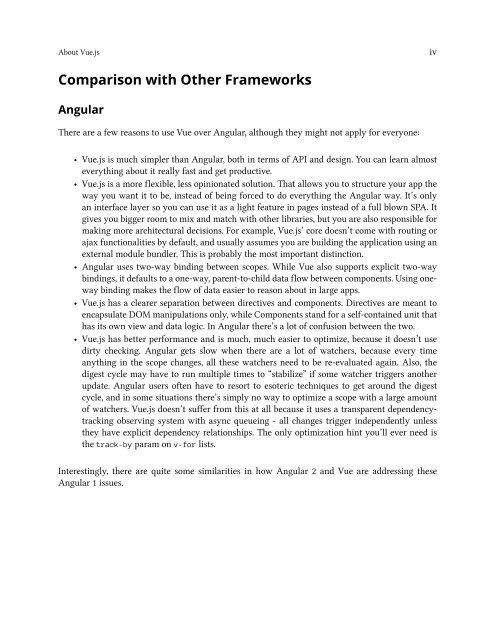vuejs
Create successful ePaper yourself
Turn your PDF publications into a flip-book with our unique Google optimized e-Paper software.
About Vue.js<br />
iv<br />
Comparison with Other Frameworks<br />
Angular<br />
There are a few reasons to use Vue over Angular, although they might not apply for everyone:<br />
• Vue.js is much simpler than Angular, both in terms of API and design. You can learn almost<br />
everything about it really fast and get productive.<br />
• Vue.js is a more flexible, less opinionated solution. That allows you to structure your app the<br />
way you want it to be, instead of being forced to do everything the Angular way. It’s only<br />
an interface layer so you can use it as a light feature in pages instead of a full blown SPA. It<br />
gives you bigger room to mix and match with other libraries, but you are also responsible for<br />
making more architectural decisions. For example, Vue.js’ core doesn’t come with routing or<br />
ajax functionalities by default, and usually assumes you are building the application using an<br />
external module bundler. This is probably the most important distinction.<br />
• Angular uses two-way binding between scopes. While Vue also supports explicit two-way<br />
bindings, it defaults to a one-way, parent-to-child data flow between components. Using oneway<br />
binding makes the flow of data easier to reason about in large apps.<br />
• Vue.js has a clearer separation between directives and components. Directives are meant to<br />
encapsulate DOM manipulations only, while Components stand for a self-contained unit that<br />
has its own view and data logic. In Angular there’s a lot of confusion between the two.<br />
• Vue.js has better performance and is much, much easier to optimize, because it doesn’t use<br />
dirty checking. Angular gets slow when there are a lot of watchers, because every time<br />
anything in the scope changes, all these watchers need to be re-evaluated again. Also, the<br />
digest cycle may have to run multiple times to “stabilize” if some watcher triggers another<br />
update. Angular users often have to resort to esoteric techniques to get around the digest<br />
cycle, and in some situations there’s simply no way to optimize a scope with a large amount<br />
of watchers. Vue.js doesn’t suffer from this at all because it uses a transparent dependencytracking<br />
observing system with async queueing - all changes trigger independently unless<br />
they have explicit dependency relationships. The only optimization hint you’ll ever need is<br />
the track-by param on v-for lists.<br />
Interestingly, there are quite some similarities in how Angular 2 and Vue are addressing these<br />
Angular 1 issues.


